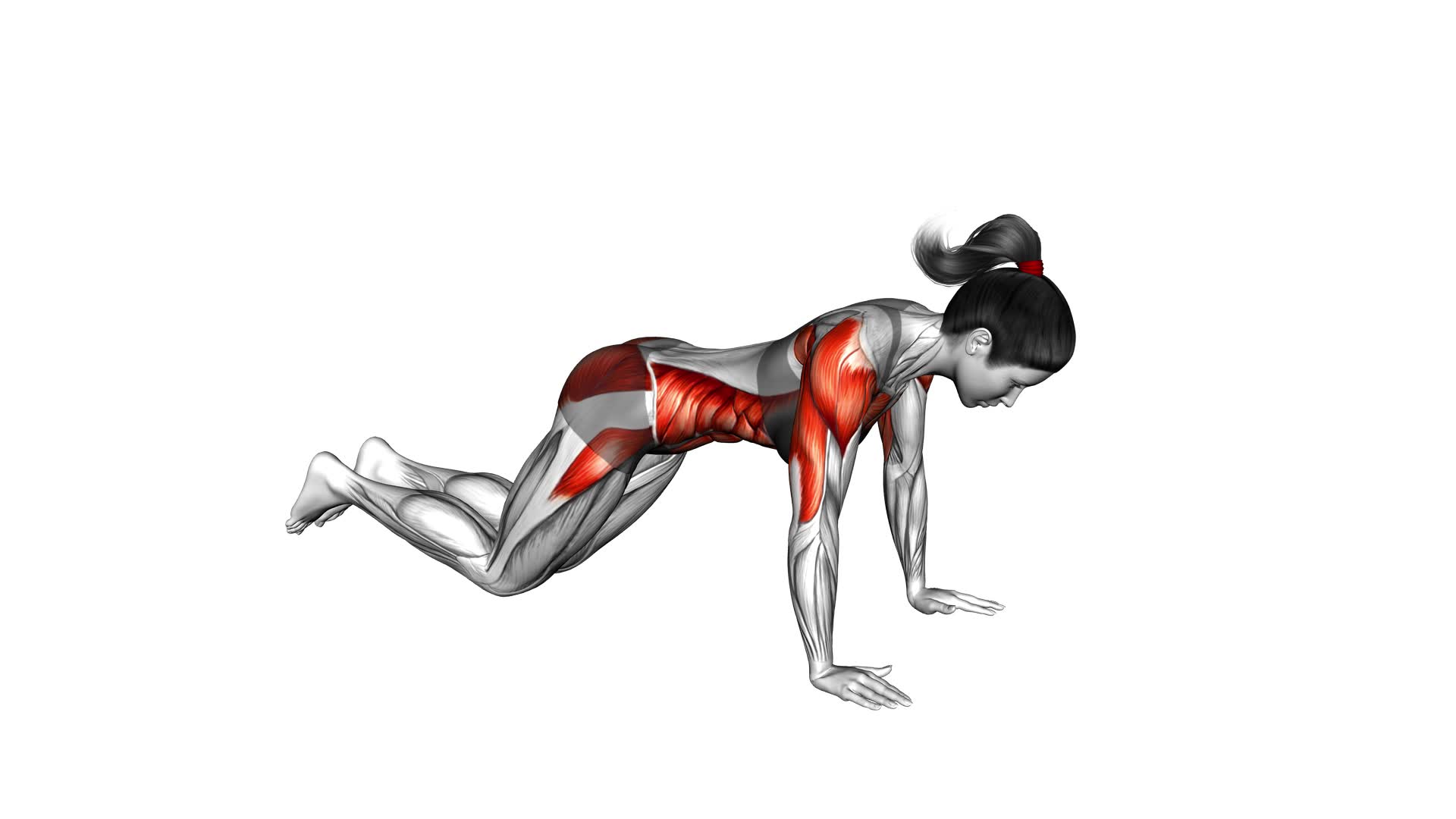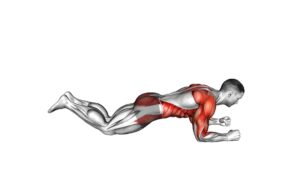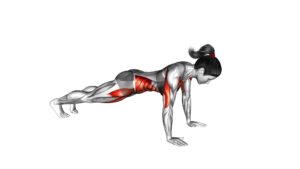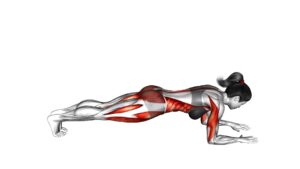Kneeling Dynamic Plank (female) – Video Exercise Guide & Tips

Are you looking for an effective exercise to strengthen your core and build stability? Look no further than the kneeling dynamic plank!
Watch This Exercise Video
In this video exercise guide, we'll show you the proper form and technique to perform this challenging move. Whether you're a beginner or an experienced fitness enthusiast, we've got modifications and advanced variations to suit your level.
Get ready to take your workout to the next level with our expert tips and guidance.
Let's get started!
Key Takeaways
- The Kneeling Dynamic Plank strengthens core muscles and improves posture
- Modifications for beginners include starting with a basic plank on knees and gradually progressing to plank on toes
- Advanced variations include elevated plank, single-leg plank, plank with rotation, and plank with knee tuck
- Consistency is important for better results, aiming for 2-3 sessions per week and allowing time for muscle recovery
Benefits of the Kneeling Dynamic Plank
Experience the numerous benefits of the Kneeling Dynamic Plank for a stronger core and improved stability. By incorporating this exercise into your fitness routine, you can effectively improve your core strength and increase stability throughout your body.
The Kneeling Dynamic Plank targets the muscles in your core, which include the abdominals, obliques, and lower back. By engaging these muscles, you can strengthen them, resulting in better posture, reduced back pain, and improved overall stability. This exercise also activates the muscles in your shoulders, chest, and glutes, further enhancing your stability.
As you perform the Kneeling Dynamic Plank, your body is forced to maintain a stable position while moving your arms or legs. This challenges your core muscles to stabilize your body against the movements, enhancing their strength and endurance. Additionally, the dynamic nature of the exercise engages your stabilizer muscles, which play a crucial role in maintaining balance and stability.
Regularly practicing the Kneeling Dynamic Plank can lead to improved sports performance, reduced risk of injury, and enhanced functional movements in your everyday life. Whether you're an athlete looking to improve your performance or someone seeking better core strength and stability, incorporating this exercise into your routine can yield significant benefits.
Start experiencing these benefits today by adding the Kneeling Dynamic Plank to your workout regimen.
Proper Form and Technique
To maintain proper form and technique for the Kneeling Dynamic Plank, it's important to engage your core and stabilize your body throughout the exercise. Here are some key points to keep in mind:
- Core Engagement: Begin by activating your core muscles. Imagine pulling your belly button towards your spine to maintain a strong and stable core throughout the entire exercise.
- Shoulder Position: Place your hands directly under your shoulders with your fingers spread wide. This will help to distribute your weight evenly and prevent unnecessary strain on your wrists.
- Hip Alignment: Keep your hips in line with your shoulders and avoid letting them sag or lift too high. This will help to maintain proper spinal alignment and engage your glutes and lower back muscles.
- Breathing: Remember to breathe steadily and deeply throughout the exercise. Inhale as you prepare and exhale as you engage your core and lift your knees off the ground.
By following these guidelines, you can ensure that you're performing the Kneeling Dynamic Plank with proper form and technique, maximizing its effectiveness and minimizing the risk of injury.
Now, let's explore some modifications for beginner fitness levels.
Modifications for Beginner Fitness Levels
To modify the Kneeling Dynamic Plank for beginner fitness levels, focus on building core strength and stability. As a beginner, it's important to start with exercises that are appropriate for your fitness level. Begin by performing a basic plank on your knees instead of your toes. This will reduce the amount of weight and pressure on your core muscles, making it easier to maintain proper form. As you build strength and stability, you can gradually progress to performing the plank on your toes.
Another modification for beginners is to reduce the duration of the exercise. Start with holding the plank for 10-15 seconds, and gradually increase the time as you become more comfortable and stronger. It's essential to listen to your body and not push yourself too hard, as this can lead to injury.
Additionally, you can utilize modifications such as using an exercise mat or placing a towel under your knees for added support and cushioning. Remember to engage your core muscles throughout the exercise to maximize its effectiveness.
By incorporating these beginner modifications and focusing on progressing at a pace that suits your fitness level, you can gradually build the strength and stability needed for the Kneeling Dynamic Plank.
Now, let's explore advanced variations for experienced individuals.
Advanced Variations for Experienced Individuals
Once you have built up your core strength and stability through the modifications discussed in the previous subtopic, you can now challenge yourself with advanced variations of the Kneeling Dynamic Plank. These advanced modifications will push your limits and take your core workout to the next level.
Here are four challenging exercises to try:
- Elevated Kneeling Dynamic Plank: Place your feet on an elevated surface such as a bench or step. This increases the intensity by placing more weight on your core and shoulders.
- Single-Leg Kneeling Dynamic Plank: Lift one leg off the ground while maintaining the plank position. This variation engages your core even more and improves balance and stability.
- Kneeling Dynamic Plank with Rotation: While in the plank position, rotate your body to one side, extending one arm towards the ceiling. This exercise targets your obliques and improves rotational strength.
- Kneeling Dynamic Plank with Knee Tuck: Bring one knee towards your chest, engaging your lower abs. Alternate between legs for an intense core workout.
Remember to maintain proper form and engage your core throughout each exercise. These advanced variations will challenge your core muscles and help you progress in your fitness journey.
Tips for Getting the Most Out of Your Workout
To maximize your workout and get the most out of your Kneeling Dynamic Plank exercises, follow these tips.
First, it's important to focus on proper form. Maintain a straight line from your head to your knees, engaging your core and glutes throughout the exercise. This will ensure that you're targeting the right muscles and maximizing your results.
Another tip is to vary your exercises. While the Kneeling Dynamic Plank is a great exercise on its own, incorporating different exercises into your routine can help to challenge your muscles in new ways. Try adding in exercises like mountain climbers, side plank leg lifts, or knee tucks to keep your workouts fresh and effective.
Additionally, make sure to listen to your body. If you're feeling fatigued or experiencing any pain, take a break or modify the exercise as needed. Pushing through pain can lead to injury and hinder your progress.
Lastly, consistency is key. Aim to incorporate the Kneeling Dynamic Plank and other exercises into your routine at least 2-3 times per week. By consistently challenging your muscles and giving them time to recover, you'll see better results over time.
Frequently Asked Questions
How Many Calories Can Be Burned by Doing the Kneeling Dynamic Plank Exercise?
Doing the kneeling dynamic plank exercise can help you burn calories and aid in weight loss.
This exercise engages multiple muscle groups, including your core, arms, and legs, which increases calorie burn.
The more intense and longer you perform the exercise, the more calories you can potentially burn.
Incorporating this exercise into your fitness routine can be an effective way to support your weight loss goals.
Can the Kneeling Dynamic Plank Help in Reducing Belly Fat?
The kneeling dynamic plank is an effective exercise for reducing belly fat. By engaging your core muscles and stabilizing your body, this exercise targets the abdominal area and helps to strengthen and tone your midsection.
Incorporating the kneeling dynamic plank into your workout routine can contribute to overall fat loss and improve your body composition. So, if you're looking to slim down your belly and achieve a more defined waistline, this exercise is worth adding to your fitness regimen.
Is It Safe to Perform the Kneeling Dynamic Plank Exercise During Pregnancy?
During pregnancy, it's important to prioritize your safety and well-being.
You may be wondering if it's safe to perform the kneeling dynamic plank exercise.
While modifications can be made for prenatal fitness, it's crucial to consult with your healthcare provider before attempting any new exercise routine.
The kneeling dynamic plank can offer benefits such as strengthening your core and improving stability.
But always prioritize your health and listen to your body throughout your pregnancy journey.
Can the Kneeling Dynamic Plank Exercise Help in Improving Posture?
Improving your posture is essential for maintaining a healthy spine and preventing back pain. The kneeling dynamic plank exercise can help in achieving this goal. By engaging your core muscles and stabilizing your body, this exercise strengthens your back and abdominal muscles, promoting better posture.
Additionally, the kneeling dynamic plank offers other benefits such as improved balance, increased core strength, and enhanced overall body stability. Incorporating this exercise into your routine can lead to significant improvements in your posture and overall fitness.
How Long Should One Hold the Kneeling Dynamic Plank Exercise to See Results?
To see results from the kneeling dynamic plank exercise, you need to know how long to hold it. The optimal duration for this exercise varies depending on your fitness level and goals.
Holding the plank for at least 20-30 seconds is a good starting point, but you can gradually increase the time as you get stronger.
Consistency is key, so aim to incorporate this exercise into your routine a few times a week.
Conclusion
Incorporating the kneeling dynamic plank into your workout routine can bring numerous benefits. This exercise is known for strengthening your core muscles and improving stability. It also enhances overall body strength.
To maximize the effectiveness of this exercise, it is important to maintain proper form and technique. This means keeping your body in a straight line from your head to your knees, engaging your core muscles, and avoiding any sagging or arching of the back.
For beginners, it is recommended to modify the plank to suit their fitness level. This can be done by starting with shorter holds and gradually increasing the duration as you get stronger. You can also perform the exercise on your forearms instead of your hands to make it easier.
On the other hand, experienced individuals can challenge themselves with advanced variations of the kneeling dynamic plank. This can include adding leg lifts, arm reaches, or incorporating instability tools such as a stability ball or a Bosu ball.
Regardless of your fitness level, it is important to listen to your body. If you feel any pain or discomfort, it is important to stop and modify the exercise accordingly.
Consistency is key when it comes to seeing results from any workout routine. It is recommended to incorporate the kneeling dynamic plank into your routine at least 2-3 times per week.
Lastly, remember to push yourself to achieve your fitness goals. As you get stronger, try to increase the intensity or duration of the exercise to continue challenging your muscles. With time and dedication, you will see improvements in your core strength, stability, and overall fitness level.

Author
Years ago, the spark of my life’s passion ignited in my mind the moment I stepped into the local gym for the first time. The inaugural bead of perspiration, the initial endeavor, the very first surge of endorphins, and a sense of pride that washed over me post-workout marked the beginning of my deep-seated interest in strength sports, fitness, and sports nutrition. This very curiosity blossomed rapidly into a profound fascination, propelling me to earn a Master’s degree in Physical Education from the Academy of Physical Education in Krakow, followed by a Sports Manager diploma from the Jagiellonian University. My journey of growth led me to gain more specialized qualifications, such as being a certified personal trainer with a focus on sports dietetics, a lifeguard, and an instructor for wellness and corrective gymnastics. Theoretical knowledge paired seamlessly with practical experience, reinforcing my belief that the transformation of individuals under my guidance was also a reflection of my personal growth. This belief holds true even today. Each day, I strive to push the boundaries and explore new realms. These realms gently elevate me to greater heights. The unique combination of passion for my field and the continuous quest for growth fuels my drive to break new ground.







